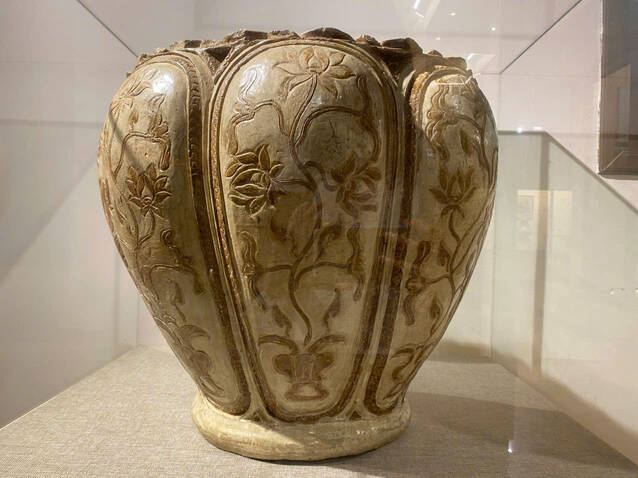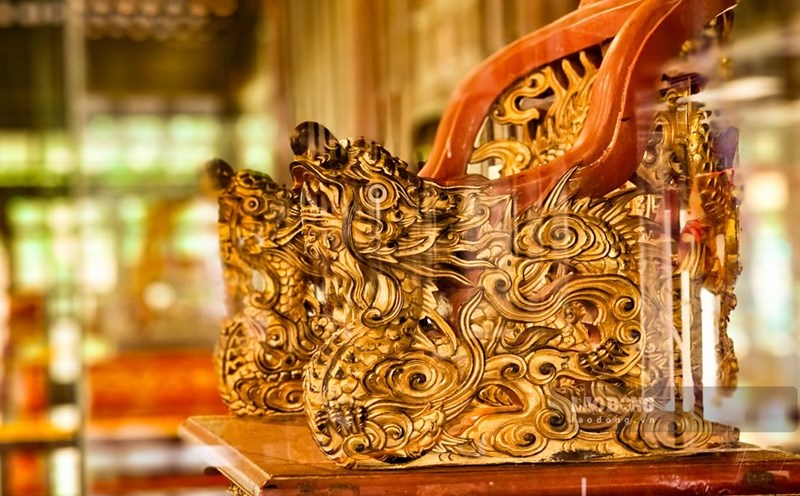Brown pottery is one of the famous pottery lines of Vietnam, imbued with folk art and occupying an important position in the pottery complex for four centuries (11th-14th centuries). This pottery line is characterized by rich, familiar decorative patterns such as lotus flowers, chrysanthemums expressed through many different layouts, styles, themes... .
Among them, the brown flower pottery collection displayed at the National Museum of History is the most valuable pottery products of the Tran Dynasty (3-14th century) including many types from large-sized knives, knives, knives, and knives to small-sized household items such as bowls, bottles, basins, etc.
A typical example of the brown flower pottery collection of the Tran Dynasty is the brown Flower Thong. This is a typical unique relic and artifact discovered at the Tran Temple relic site, associated with the most prosperous and famous Phong kien Dynasty throughout the nation's history.
Ceramic masterpieces of the Ly - Tran Dynasty
According to information from the National Museum of History: A pile of brown flowers was discovered when people dug a well at Tran Temple, Tuc Mac Village, Loc Vuong Ward, Nam Dinh City, in 1972,
The mouth is round and bulky, 52cm high; the mouth is 35cm wide. The Thong has a round mouth that floats in an edge, the bulge body divided into 8 bags and gradually settles down to the bottom, on the shoulders are lotus petals with two layers of brown edges, large petals interspersed with small petals, low base, and slightly shiny.

The bag is divided into 8 lotus-shaped bags, each bag decorated with a lotus flower bottle painted with brown enzyme on the white enzyme background: A bag is a lotus flower branch made of 3 lotus flowers blooming all over, 4 lotus leaves arranged evenly. This lotus flower branch is stuck in a jar with a high base. The bags are surrounded by a strip of ribbon-shaped female flower petals.
The brown flower cluster belongs to a type of high-quality pottery, large in size; has a strong shape, thick pottery, rough soil, inside the carrier without fertilizer, the decorative project on the system is carved into a foundation and then used brown color taken from red soil, painted into a piece. Finally, a layer of indigo yellow enzyme is applied.
This is the most typical decoration project creation technique in the history of pottery making of the nation, because only the Tran Dynasty (Northern region of Vietnam) had such a technical way to create decorative projects on ceramics. This is a way to demonstrate the experience, processing techniques, ability to master raw materials and the heating temperature of contemporary pottery artisans.
The brown flower bed bears a strong Buddhist imprint because the image of Lotus - lotus flower is the symbol of the Buddha's house. During the Tran Dynasty, Vietnamese Buddhism began to flourish, entering a period of prosperity. The event of King Tran Nhan Tong giving up his throne to his son and then going abroad to monk's house at Yen Tu pagoda (Yen Tu mountain, Quang Ninh), after which he was the one who established the Truc Lam Yen Tu Zen school. This is the fruit of the Zen school's flowering.

Brown flower beds impressed by the location where they were discovered
Also according to the National Museum of History; in the 1960s, the land of Tu Mac was upgraded by the Tran Dynasty to become Thien Truong province with many majestic and splendid castles and palaces; typically, Trung Quang palace where the Thuong Dao ruled, Trung Hoa palace for the Tran Kings to return to the throne. At that time, Thien Truong quickly became a large citadel just behind Thang Long.
In the resistance wars against the invasion, Thien Truong was also the center and military base. Because when the kings were chased by the enemy, they all fled from Thang Long to Thien Truong. And also from Thien Truong, the Tran kings continued to build forces, then sent troops to fight and reclaim Thang Long.
Thien Truong has been attached to the Tran Dynasty for its entire 175 years, contributing significantly to the resistance war against the Chinese-Mong army's invasion. Then throughout the history of the Le - Mac, Tay Son - Nguyen dynasties, the land of Thien Truong has always been the cultural and economic center of the coastal region.
The brown Thong Hoa was discovered right in the central area of the ancient palace, which was the base of the Trung Quang and Trung Hoa palaces.
With its large size, facade and decorative patterns imbued with Buddhist elements, associated with historical values, the unit's location has become a unique work of art, a masterpiece in the complex of Vietnamese ceramics in general, and brown flower ceramics in particular. The origin of the trunk in Thien Truong palace - the palace of the Tran Dynasty - where the pottery was produced for "use" has confirmed that it is a Royal item.
Each national treasure is a precious heritage containing messages from the past, the quintessence of the rich, diverse, and unique Vietnamese culture, reflecting the long-standing cultural history and tradition of building and defending the country of the Vietnamese people.
With the brown flower Thong, that value is fully expressed through sophisticated processing techniques and decorative styles imbued with the cultural and religious identity of the Tran Dynasty.
Thong was recognized as a National Treasure in 2016, currently on display at the brown pottery collection area, Tran Dynasty (1226-1400) on the second floor of the National History Museum - No. 1 Trang Tien, Hoan Kiem District, Hanoi.











